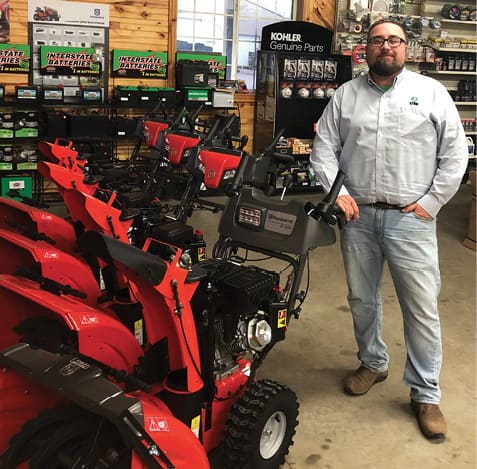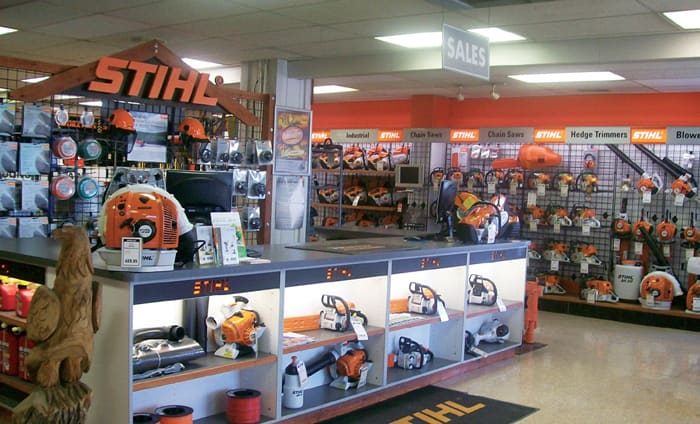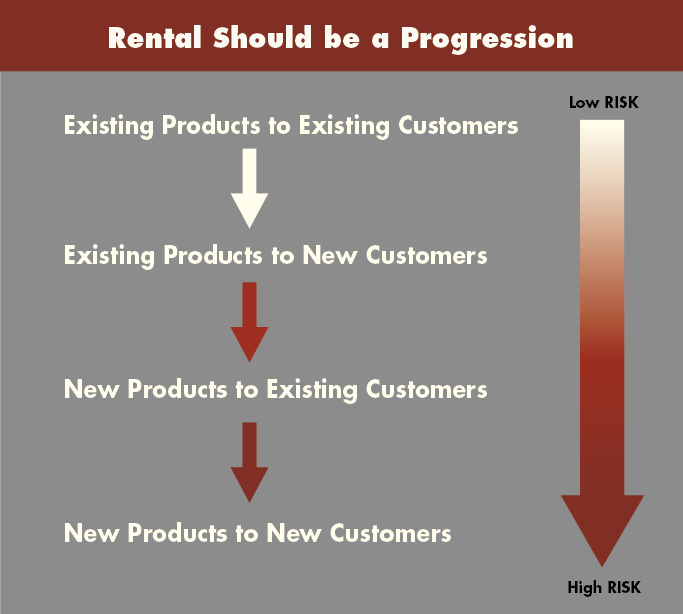Larry Kaye, CEO of Script Intl., and Rural Lifestyle Dealer Staff
Strong forecasts and other factors mean it’s time to take a closer look at equipment rental so you’re not missing out on revenue opportunities. For starters, the American Rental Assn. forecasts total equipment rental revenue in the U.S. to grow by 4.5% this year, 5.6% in 2019, 5% in 2020 and 4.4% in 2021. Canada is expected to have similar levels of growth.
A listing of the top 100 rental companies in the U.S. shows volume has reached an all-time high and is up 13.6% from last year. United Rental, which tops that list, reported a 19.3% increase in rental revenues for the second quarter.
A changing customer demographic will contribute to future growth, says Larry Kaye, CEO of Script Intl., a consulting company for the construction industry. “As millennials enter adulthood and the middle class, the trend seems to be for them to own less stuff. Not only is there a thriving minimalist movement, but the advent of the digital and sharing economies have made this much easier. Considering this change in the consumer mindset, our industry needs to be on its toes,” he says.
“Rental is now integral to gaining market share …”
— Larry Kaye, CEO of Script Intl.
Kaye cites other positive influences on rental, such as changes in the customer/dealer/manufacturer relationship and flat revenues coming from parts and service. Read on for Kaye’s recommendations for how dealers can enter and succeed in the rental market. Jason Bagniewski of D&D Equipment, Arcadia, Wis., shares his thoughts in the sidebar, “D&D Farm Supply’s View of Rental,”. Go online for more comments from other dealers: www.RuralLifestyleDealer.com/DealerCommentsRental.
Changing Distribution
While consulting with Caterpillar in the ‘90s, we were asking this question: Is rental a market segment or is it a channel of distribution? Since then, rental as a channel of distribution has been clearly established. Through various consolidations of smaller rental companies, we now have publicly traded rental companies with hundreds of locations. In many cases, these companies have better buying power than the dealer, so they can bypass a dealer and work directly with a manufacturer for equipment as well as parts. This has forced manufacturers to develop a rental strategy.

Larry Kaye is CEO of Script Intl.
Dealers need to recognize that rental is now integral to gaining market share. For instance, let’s say you sell skid steer loaders and there’s a large rental company nearby that carries the competing brand. In terms of your market share, you are going backward because that other brand has more machines in your territory. This puts incredible pressure on dealers and there is absolutely no way they can sell machines fast enough to keep up. What’s more, protected territories are now being infiltrated by rental companies that have no territories.
Customers are also turning more and more to the internet and are not as dependent on a dealer for parts and services. Data from the Assn. of Equipment Distributors suggests that parts sales (as a percentage of total revenues) has been steady at 20% over the last 5 years. Service revenues (as a percentage of total revenues) has remained slightly below 10% during the same period. In the traditional business model of sales, parts and service, the two that make the most margin are flat or in decline. That means a dealer has to make up 70% of his business through sales, the area with the lowest margin. Rental, which offers gross profit margins (GPM) of 30% or more can be the solution.
Rent-to-Rent vs. Rent-to-Sell
Many of the dealers I have worked with over the last few years have found themselves “tiptoeing” in the rental business. They didn’t enter the market intentionally, but rather as a gut reaction to customer demand. Many of these dealers are engaging in renting with the goal of selling the equipment as soon as possible. Commonly known as Rent-to-Sell (RTS), these machines are considered new inventory and when they are rented, 80% of the rental charges are booked as depreciation against the unit. This accelerates the decrease in net book value (NBV) with the express purpose of being able to retail the machine at a lower price point and still make the target profit margin.
Rent-to-Rent (RTR) fleets include machines that have been selected to serve the local market and deliver annual profits to the dealership. These units show up on the balance sheet as assets of the company and typically have a corresponding debt service. On average, equipment stays in a RTR fleet for 3-4 years, before moving to used inventory. Typically, rental revenues earn a minimum of 30% GPM, while a target of 20% GPM should be the minimum target on selling a used rental machine.
Projecting Return
Before entering the rental market, you have to be prepared to make investments in equipment. Deciding what equipment to invest in depends a lot on what you are already selling.
First, segment all your customers into 10-20 categories, such as farmers, utility contractors, road builders, concrete contractors, etc. Then, run a revenue report by those segments and start asking the largest group what they are renting now, from whom, how often and what services they expect. This data should help identify the rental machines you should have in your fleet to get started. You need to have a minimum of 2-3 units in any identified model to be a reliable source of rental equipment.
If you are new to rental, don’t plan on more than 30-40% time utilization of your fleet. You have to prove yourself to customers before they will trust you enough to switch from their current supplier.
Next, check the daily, weekly and monthly rates of area rental companies to start projecting returns on your investment. Expect somewhere between 28-35 cents of revenue for every dollar of equipment value at the beginning. Longer term goals should be 50% or higher for time-out utilization and revenue goals of 35-40% (annual rent revenue/original equipment cost) depending on the types of machines in your fleet. Smaller machines typically have a higher rate of return.
Don’t try to be everything to everybody at first. Start by renting existing products to existing customers and then existing products to new customers. Move on and sell new products to existing customers and then new products to new customers. (See the chart, “Dealer Rental Should be a Progression.”)
Location Must-Haves
As the rental industry has matured over the last 40 years, it is increasingly becoming a logistics game. Having the right machines in your rental fleet does not guarantee success. You must have convenient, easily accessible locations that are strategic to your market coverage and the ability to deliver equipment efficiently.
Additional service points that are vitally important for success include:
- Ease of doing business
- Online access to information or account management
- Fleet management through use of telematics
- Accurate rental invoicing
- Insurance requirements for renting equipment
Take a look at your location and see how it might accommodate rental pick-up and drop-off. You need space to display rental equipment and make it clear the equipment is not just additional inventory or equipment waiting for repair. You’ll need signage to say, “We now rent equipment.”
D&D Farm Supply’s View of Rental

Jason Bagniewski owns D&D Farm Supply of Arcadia, Wis. The dealership has been in the rental business for more than 20 years and has evolved its inventory to meet market demands.
Rental does offer revenue opportunities if dealers are prepared for the competition and are ready to adapt to changing demands.
D&D Farm Supply of Arcadia, Wis., has been offering rental equipment for more than 20 years. It was a good addition for the dealership and the owner Jason Bagniewski thinks their rental department will continue grow. However, success is not a guarantee.
“We started rental to generate income and cash flow and it gets equipment that may be new or unique in front of customers. Stocking the right tractor can be a challenge when markets are what they are now, so sometimes, to get the price down on them, we put them in the rental program,” Bagniewski says. “There can be a lot of competition out there. In our area, there are three or four others offering tractor rentals. We don’t offer a major hardware line at D&D, but we do compete with local hardware stores on certain rental items.”
The dealership, which carries Kuhn, McCormick, Farm King, Vermeer, Fimco Industries and other lines, rents equipment for agriculture, commercial and residential landscaping and related industries. He says preferences and demand can change, especially based on the season. For instance, they used to rent log splitters but demand lessened as landscapers and homeowners can afford less expensive models that are now available.
Bagniewski looks at rate of return but says sometimes it’s a “gut reaction” to what kind of equipment to offer, how many units of each and how to set rates. “We usually like to get the first one paid off so everything’s profit after that point. It can be difficult to do that because sometimes you come to the end of the life of the equipment,” he says.
At D&D Farm Supply, rental is handled by the parts salesperson, including inspections after the equipment is returned. However, Bagniewski is rethinking that role. He says the new battery-powered equipment could bring in new customers and lessen hassles for the dealership related to servicing engines, replacing filters, etc.
“As far as robotic mowers, I don’t know if I can see a fit for rental yet, but it’s a growing area. People seem to have less and less time to mow their lawns,” he says.
Landscapers are also a solid market for rental because of their need to use equipment, such as snow removal equipment, for only a limited time each year.
“Our rental offerings will continue to grow and we’ll phase out products and bring new products in and keep trying to get better at it,” Bagniewski says.
An important part of rental is the process. Think about the process of renting and returning equipment. Decide how you will bring the equipment in for inspection, who will do the inspection, who will do the maintenance, etc. A smooth and fast process keeps fleet utilization high. You will eventually need a rental manager, but you could start with a rental coordinator; just somebody to handle the transactions.
Selling Rental
Get your sales team ready for rental means setting up a compensation structure to get your sales people excited about promoting rental. You don’t want them thinking that rental is a lost sale. I highly recommend that your salespeople have meaningful participation in rental revenues. A salesperson probably needs to earn 20-25% of their total earnings from rental.
They also need to be taught that rentals can help sales efforts. As customers learn about your dealership and the brands you sell through rentals, you should have earned their trust by the time they are ready to buy.
Rental also offers your sales team a steady stream of used inventory. Have your team research missed used sales opportunities to help determine when to move a machine out of the rental fleet based on customer inquiries and demand.
Know Your Customers
Your reputation in the marketplace is an early decision point for rental customers. However, customers will need to vet you as a rental option first. Machine availability is usually the first decision point when a customer is renting. You might have the machine in your fleet, but you could lose the rental if it’s at the wrong location or if it is waiting to be serviced. Customers also evaluate your commitment to rental, so you need to have depth in your inventory.
Fleet reliability is a high priority. Rental equipment needs to have low hours, be well maintained and be supported by a service staff. In addition, if your service department is not onboard with supporting the rental fleet as if it was the very best customer of the dealership, this could be a real obstacle
to your success.
Customers may say that rental rates are their highest priority when considering a rental provider, however, survey data says that fleet availability and reliability are more important than rental rates.
Servicing Rental Equipment
The service department will need to be ready to support the rental business as well. As the fleet grows, I recommend having a separate service tech for the rental department. Their tasks include assembling equipment, inspecting it and cleaning it. They may also help the customer load and unload equipment. They don’t necessarily have to be factory trained, but should have a general knowledge of service procedures. These employees are low- to mid-level technicians in terms of pay range and they are part of the rental department’s overhead.
Dealer Takeaways
- Consider that the equipment distribution model is changing and rental can make up low margins in other areas.
- Evaluate your location, facility, people and processes to make sure you offer convenience along with the right equipment.
- Be ready to invest in multiple units and be realistic about utilization and return.
- Research demand for used equipment to help determine when to move rental equipment to your used inventory.
A side benefit is that your rental department can turn into a kind of apprenticeship program. You teach these rental techs the basics of your operation and your equipment and as their skills improve, you may bring them into the service department and provide additional training.
Dealing with Liability
Liability and customer safety tend to be other major concerns for dealers considering rental. You’ll need to have a rental contract to spell out the terms and conditions. There are some boilerplate rental contracts that provide a starting point, but you need one supports the laws for your state. I would advise a dealer have their attorney review any contract to ensure they are protected.
Adapting to Change
Our industry is moving at a rapid pace and manufacturers are going to the market with or without their existing dealer networks. If you are ignoring that, my warning is to wake up, so you don’t get run over in the marketplace. You don’t want to spend 20 or 30 or 40 years building a business and have nothing to sell or to pass on to the next generation.






Post a comment
Report Abusive Comment